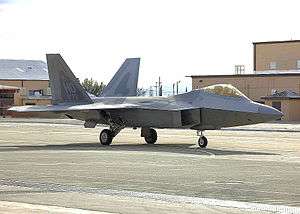8th Fighter Squadron
| 8th Fighter Squadron | |
|---|---|
|
F-22A block 20 04-407, 8th FS taxiing at Holloman AFB on the afternoon of December 21st, 2009 | |
| Active |
15 January 1941 - 16 May 2008 25 September 2009 – 19 May 2011. |
| Country |
|
| Branch |
|
| Type | Squadron |
| Role | Air Supremecy |
| Nickname(s) | The Black Sheep |
| Engagements |
World War II (Asia-Pacific Theater) Korean War Kosovo Campaign Operation Iraqi Freedom GLobal War on Terrorism |
| Decorations |
Distinguished Unit Citation (5x) Air Force Meritorious Unit Award Air Force Outstanding Unit Award (3x) Philippine Presidential Unit Citation Republic of Korea Presidential Unit Citation (2x) |
| Insignia | |
| 8th Fighter Squadron emblem |
 |
The 8th Fighter Squadron (8 FS) is an inactive United States Air Force squadron, last assigned to the 49th Operations Group, stationed at Holloman Air Force Base, New Mexico. The squadron was inactivated on 19 May 2011.
History
World War II
The 8th Fighter Squadron traces its origins to the formation of the 49th Pursuit Group (Interceptor) at Selfridge Field, Michigan on 20 November 1940. The 8th Pursuit Squadron was equipped with Seversky P-35s that were transferred from the 1st Pursuit Group that departed to Rockwell Field, California. In May 1941, the squadron proceeded to Morrison Field, West Palm Beach, Florida, to train in the Curtiss P-40 fighter.[1][2]
With the advent of World War II, the squadron moved to Australia and became part of Fifth Air Force in January 1942. It was re-designated as the 8th Fighter Squadron in May 1942. The unit received Curtiss P-40 Warhawks in Australia and, after training for a short time, provided air defense for the Northern Territory.[2]
The squadron moved to New Guinea in October 1942 to help stall the Japanese drive southward from Buna to Port Moresby. Engaged primarily in air defense of Port Moresby; also escorted bombers and transports, and attacked enemy installations, supply lines, and troop concentrations in support of Allied ground forces.[2]
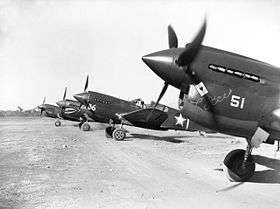
The 8th participated in the Allied offensive that pushed the Japanese back along the Kokoda Track, took part in the Battle of the Bismarck Sea in March 1943, fought for control of the approaches to Huon Gulf, and supported ground forces during the campaign in which the Allies eventually recovered New Guinea. It covered the landings on Noemfoor and had a part in. the conquest of Biak.[2]
It was during this time that the 8th acquired their colorful name "The Black Sheep" Squadron. While the 7th and 9th squadrons received new aircraft, the 8th received the older aircraft being replaced by the other squadrons. Unhappy with being last on the supply line and not liking the unlucky "Eightballs" name caused the pilots to begin calling the 8th “The Black Sheep" Squadron. The name stuck and a Disney artist designed the distinctive logo.[3] After having used Lockheed P-38 Lightnings, Curtiss P-40 Warhawks and Republic P-47 Thunderbolts, the 8th was equipped completely in September 1944 with P-38's, which were used to fly long-range escort and attack missions to Mindanao, Halmahera, Seram, and Borneo. The unit arrived in the Philippines in October 1944, shortly after the assault landings on Leyte and engaged enemy fighters, attacked shipping in Ormoc Bay, supported ground forces, and covered the Allied invasion of Luzon.[2]
Other missions from the Philippines included strikes against industry and transportation on Formosa and against shipping along the China coast. During World War II the 8th FS amassed an impressive record of 207 aerial victories. Notable “aces” included Robert W. Aschenbrener (10), Ernest Harris (10), Robert White (9), George Kiser (9), Sammie Pierce (7), James Morehead (7), Willie Drier (6), James Hagerstrom (6), Robert Howard (6), Don Meuten(6), Nial Castle(5), William Day (5), Marion Felts (5), Nelson Flack (5).[4] The 8th Fighter Squadron and its sister squadrons (7th Fighter Squadron and 9th Fighter Squadron) attained a record of 668 aerial victories not matched in the Pacific Theater during World War II.[2]
After the Japanese Capitulation, the squadron moved to the Japanese Home Islands, initially being stationed at the former Imperial Japanese Navy Atsugi Airfield, near Tokyo on 15 September 1945. Its war-weary P-38 Lightnings were sent back to the United States and the squadron was re-equipped with P-51D Mustangs with a mission of both occupation duty and show-of-force flights. In February 1946, the squadron was moved to Chitose AB, on northern Honshu and assumed an air defense mission over Honshu and also Hokkaido Island. The pilots of the squadron were briefed not to allow any Soviet Air Force aircraft over Japanese airspace, as there was tension between the United States and the Soviet Union about Soviet occupation forces landing on Hokkaido. In April 1948, the squadron moved to the newly-rebuilt Misawa AB when the host 49th Fighter Group took up home station responsibilities. At Misawa, the squadron moved into the jet age when it was re-equipped with the F-80C Shooting Star.[5]
Korean War

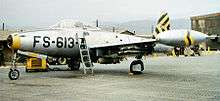
With the outbreak of the Korean War in June 1950, the 8th was one of the first USAF squadrons dispatched to Korea from Japan, initially operating propeller-driven F-51Ds to cover the evacuation of civilians from Kimpo and Suwon. Next, it flew close air support missions to help slow the advancing North Korean armies. Later, it turned to the interdiction of enemy troops, supplies and communications from Misawa. However its short-range F-80Cs meant that the 49th had to move to South Korea in order for them to be effective.[5]
The squadron moved to Taegu AB (K-2) on 1 October 1950, becoming the first jet fighter outfit to operate from bases in South Korea. During the autumn of 1950 and spring of 1951, the squadron flew combat missions on a daily basis from Tageu, flying escort missions for B-29 Superfortresses over North Korea and engaging Communist MiG-15 fighters in air-to-air combat. When the Chinese Communist Forces (CCF) Intervention Campaign gained momentum in 1950–1951, the squadron again concentrated on the ground support mission, attacking Communist Chinese ground units in North Korea, moving south until the line was stabilized and held just south of Seoul.[5]
The 49th changed equipment to the F-84G Thunderjet in mid-1951, It engaged Communist forces on the ground in support of the 1st UN Counteroffensive Campaign (1951). Afterwards, it engaged primarily in air interdiction operations against the main enemy channel of transportation, the roads and railroads between Pyongyang and Sinuiju. Also, it flew close air support missions for the ground forces and attacked high-value targets, including the Sui-ho hydroelectric plants in June 1952 and the Kumgang Political School in October 1952. On 27 July 1953, the squadron joined with the 58th FBG to bomb Sunan Airfield for the final action of F-84 fighter-bombers during the Korean War.[5]
The wing remained in Korea for a time after the armistice. It was reassigned to Japan in November 1953 and returned to its air defense mission. The squadron upgraded to the F-86F Sabre in 1956. By late 1957, however, Worldwide DOD Budget restrictions during FY 1958 meant that the 49th FBW would be inactivated as part of a reduction of the USAF units based in Japan.[5]
United States Air Forces in Europe
Due to seniority, after the 49th's inactivation in Japan, the designation replaced the 388th Fighter-Bomber Wing at Etain-Rouvres Air Base, France on 10 December 1957 in a same-day, name-only transfer. The 8th FBS assumed the aircraft, personnel and equipment of the 562d Fighter-Bomber Squadron which was inactivated. As the 49th had been a part of American forces in the Pacific since it was sent to Australia in January 1942, the assignment to Europe after fifteen years in the Pacific was a major change for the organization.[5]
Taking over the seven F-100D Super Sabres and three dual-seat F-100F trainers of the 561st, the squadron continued its normal peacetime training. The squadron began keeping four of its planes on 15-minute alert (Victor Alert) on 1 February 1958 so a portion of the squadron could react quickly in an emergency. During the fall of 1958, most of the squadron operated from Chalon-Vatry Air Base while the runway at Etan was being repaired and resurfaced.[5]

However, the nuclear-capable F-100 was troublesome to the host French Government, the French decreed that all United States nuclear weapons and delivery aircraft had to be removed from French soil by July 1958. As a result, the F-100s of the 49th FBW had to be removed from France. After negotiations with the French, the 49th's Wing commander was informed that the wing would be departing from France on 1 July 1959 and be moved to Spangdahlem AB, West Germany. During the relocation to West Germany, the squadron deployed to Wheelus Air Base, Libya, for gunnery training. However, not all squadron personnel moved to Spangdahlem, as many of the 10th Tactical Reconnaissance Wing personnel there were almost at the end of their tours and did not want to move to RAF Alconbury, where the 10th was being relocated to in order to accommodate the 49th. As a result, some squadron ground support personnel instead moved to RAF Lakenheath, England to backfill vacancies there, while the 10th TRW personnel at Spandahlem were allowed to finish out their assignments.[5]
At Spangdahlem, the squadron flew F-100s until 1961 when it converted to the Republic F-105D/F Thunderchief, commonly known as the "Thud". The 49th TFW was only the third USAF unit to operate the F-105. As part of USAFE, the 8th participated in many NATO exercises. In February 1967, the 8th opened the 49th Weapons Training Detachment at Wheelus Air Base, Libya, to begin transition to the McDonnell Douglas F-4D Phantom II, and received its first F-4D on 9 March 1967.[5]
In the late 1960s, the Defense Budget began to be squeezed by the costs of the ongoing Vietnam War. Secretary of Defense Robert MacNamara decided to reduce costs in Europe by "Dual Basing" United States military units in Europe by returning them permanently to the United States, and conducting annual deployment exercises in Europe, giving the units a NATO commitment for deployment to bases in Europe if tensions with the Soviet Union warranted an immediate military buildup. The 49th Tactical Fighter Wing was returned to the United States under this policy, being reassigned on 1 July 1968 to Holloman Air Force Base, New Mexico, to serve as the US Air Force’s first dual-based, NATO-committed wing.[5]
Holloman Air Force Base
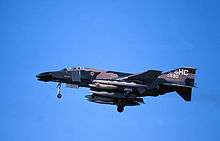

At Holloman, the squadron participated in Tactical Air Command tactical exercises and firepower demonstrations to maintain combat readiness.[5] Also, the first "Tail Codes" to identify squadron aircraft were applied, rather than the traditional yellow colors of the 8th which had been used since the Korean War. Initially "HC" was the tail code identifier for the 8th, however, in 1972, the Air Force issued AFM 66-1 which specified wing tail codes and the squadron's planes were standardized on the 49th's "HO" tail code. However, a yellow tail stripe was applied to identify squadron aircraft.[6]
The 8th also retained its NATO commitment to return once a year to its "dual base" home in West Germany. These deployments were known as "Crested Cap", and were as follows:
- Ramstein AB, West Germany, 13 September-8 October 1970 (F-4D)
- Ramstein AB, West Germany, 9 September-6 October 1971 (F-4D)
- Bitburg AB, West Germany, 2 March-2 April 1973 (F-4D)
- Hahn AB, West Germany, 6 September-6 October 1975 (F-4D)
- Ramstein AB, West Germany, 22 September-20 October 1976 (F-4D)
- Ramstein AB, West Germany, 22 August-22 September 1977 (F-4D)
- CFB Lahr, West Germany, 24 August-16 September 1981 (F-15A)
- Gilze-Rijen AB, Netherlands, 14 June-11 July 1990 (F-15A)[5]
With the end of the Cold War and subsequent force drawdowns by USAFE, these annual exercises ended in 1991.
Takhli Royal Thai Air Force Base
On 4 May 1972, after North Vietnam invaded South Vietnam, the entire wing, except for a rear echelon that remained to run Holloman, deployed at Takhli Royal Thai Air Force Base, Thailand. Operation Constant Guard III, ordered in response to the North Vietnamese invasion, was the largest movement that the Tactical Air Command (TAC) had ever performed. In nine days, the squadron deployed its F-4D Phantom IIs from Holloman to Takhli. Airmen arriving reported that Takhli was a mess, with missing or broken plumbing fixtures, no hot water, and no drinking water - that had to be trucked in from Korat every day. Bed frames had been thrown out of the hootches into the high snake-infested grass, and mattresses or bedding consisted of sleeping bags at best.[5]
The 8th TFS flew combat sorties in South Vietnam, Cambodia, and Laos from 1 July – 24 September 1972 during Operation Linebacker, the bombardment campaign in North Vietnam. During this deployment, Operation Constant Guard, the squadron flew over just about every battle zone from An Loc to vital installations in the Hanoi vicinity. During five months of combat, the squadron did not lose any aircraft or personnel. The unit officially closed out its Southwest Asia duty 6 October 1972.[5]
F-15A Eagle era

In October 1977, the 49th TFW ended its "dual-base" commitment to NATO and changed to an air superiority mission with the wing beginning a conversion from the F-4D Phantom II to the F-15A Eagle, the 49th being the second USAF operational wing to receive the F-15A. The transition was completed 4 June 1978.
Due to the change in equipment, the annual NATO deployments were taken over by the 4th Tactical Fighter Wing, Seymour Johnson AFB, in 1978; however they resumed (although not on an annual basis) in 1981. In the United States, training missions was refocused on dissimilar air combat tactics for multi-theater operations, participating in numerous Red Flags, Joint Training exercises, and deployments in the Air Defense/Superiority Mission. Frequent deployments were made to Nellis AFB, Nevada to exercise with the F-5E Tiger II "Aggressor" aircraft of the 57th Fighter Weapons Wing, and other aircraft types (including clandestine exercises with Soviet aircraft flown by the 4477th Test and Evaluation Squadron at Tonopah Test Range Airport, Nevada). Also, after TAC absorbed the interceptor mission of Aerospace Defense Command (ADTAC) in 1979, the squadron maintained the TAC NORAD Air Defense Alert commitment in the Eagle, with the best scramble times in NORAD.[5]
With the introduction of the F-15C Eagle in the mid-1980s, the upgraded Eagle began replacing the F-15A/Bs in service with all of the USAF units that had previously been operating the Eagle with the exception of the 49th TFW. By the time of Operation Desert Storm in 1991, the F-15A Eagles at Holloman had been relegated to a training role; combat deployments of the Eagle were the purview of F-15C units.[5]
F-117 Nighthawk era

In 1992, the 49th FW underwent a number of transitions. As a result of the end of the Cold War, reduced defense budgets were the order of the day. As a result, the 8th Fighter Squadron retired its F-15A Eagles and received the F-117A Nighthawk Stealth Fighters of the 37th Fighter Wing 416th Fighter Squadron, which was subsequently inactivated.[5]
After conversion to the F-117A in May 1992, The 8th deployed fighters and their crews to Southwest Asia during the 1990s as part of Operation Southern Watch to support United Nations weapons inspectors in Iraq, to enforce the no-fly zone over the southern part of that country to deprive Saddam Hussein of his Weapons of Mass Destruction (WMD) programs and to force his compliance with the UN monitoring regime. 8th F-117s fighters deployed to the Gulf in 1998 during Operation Desert Fox to upgrade the strike force's capability to attack high-value targets. But the 18-hour flight from Holloman AFB to Kuwait meant that the operation was over before the F-117 aircraft arrived in the Gulf.[5]
Operation Allied Force

In early 1999, the 8th deployed F-117 and their crews to Aviano Air Base, Italy and Spangdahlem Air Base, Germany from 21 February – 1 July 1999, in support of Operation Allied Force, the NATO attempt to stop ethnic cleansing in Kosovo in the former nation of Yugoslavia. In the opening phase of the operation, aimed primarily at Yugoslavia's integrated air defense system, NATO air forces conducted more than 400 sorties. During the first two night attacks, allied air forces struck 90 targets throughout Yugoslavia and in Kosovo. F-117 Nighthawks from the 8th Expeditionary Fighter Squadron participated in air strikes against targets in the Balkans during NATO operations bravely trusting in their aircraft's low observable technology struck some of the most valuable and highly guarded targets in Serbia. The F-117s successfully penetrated the heavily defended areas, which conventional aircraft could not reach.[5]
One F-117 fighter was lost over Yugoslavia on 27 March 1999, apparently struck by a salvo of SA-3 Goa surface-to-air missiles. Unknown to NATO, Yugoslav air defenses operators had found they could detect F-117s with their "obsolete" Soviet radars after some modifications that could detect the aircraft when their wheels were down or bomb bay doors were open. A US search and rescue team picked up the pilot several hours after the F-117 went down outside Belgrade. This was the first and so far the only F-117 to have been lost in action. On 1 April 1999, Defense Secretary William Cohen directed 12 more F-117 stealth fighters to join NATO Operation Allied Force, to join the total of 24 F-117s that were participating in NATO Operation Allied Force.[5]
Operation Enduring Freedom

People, airplanes, and equipment of the 49th Fighter Wing played a key role in Operation Iraqi Freedom. The wing's F-117s played a major role, dropping the first bombs against an Iraqi leadership target in Baghdad on 19 March 2003.[5]
Deployed to Al Udeid Air Base, Qatar, assigned to the 379th Air Expeditionary Wing, on the opening night of the invasion, fresh intelligence was received that Iraqi President Saddam Hussein was staying at a specific bunker for the night. USAF planners had a rare opportunity to kill the elusive Iraqi leader. It was reasoned that might bring down his regime without war. The F-117s would carry the new GPS-guided EGBU-27 precision guided bomb. The problem was it had never been used in combat and the weapons had arrived at Al Udeid a mere 24 hours earlier.[7]
Combat preparation of the fighters began immediately. The plan called for the F-117s to take off as soon as possible. Two stealth fighters roared northward into the nighttime sky at 3:38 a.m. After refueling over the Gulf near Kuwait City, the stealth fighters split up and took separate routes over Iraq to the target area. The sun was starting to come up and the sun was starting to come up by the time the pilots reached Baghdad, however on that morning Baghdad was obscured under low-level clouds. Each of the two F-117s released two bombs, which plummeted toward the bunker in which Saddam Hussein was believed to be sleeping. Release came at 5:30 a.m., 13 minutes after dawn but only five hours after the pilots first heard that such a mission might be in the offing. The strike caught Iraqi defenses completely off guard. Defensive anti-aircraft fire did not begin until the aircraft had completed the attack and were racing out of the Baghdad area.[7]

Although the strike did not kill Saddam Hussein, what it did accomplish was to allow the coalition to seize the initiative. Also the EGBU-27 immediately became the F-117’s premier weapon. According to Air Force data, 98 of them were delivered during the conflict, compared to only 11 of the traditional, predominantly laser versions.[7] During Operation Iraqi Freedom, F-117 pilots flew more than 80 missions and dropped nearly 100 enhanced guided bomb units against key targets. Approximately 300 people deployed with the air package and provided direct support to the F-117 mission.[5]
In 2006, the Air Force announced that Holloman AFB would cease to be the home of the F-117A Nighthawk, coinciding with the announcement that the aircraft was set to be retired from service by 2008. The planes were sent to their former base at Tonopah Airport, Nevada for retirement and long-term indoor storage. Tonopah was selected to store the aircraft as it was stated that even in retirement, the stealth technology of the aircraft remained classified. Therefore, the planes would be stored in their former hangars where they were originally kept during the years the existence of the aircraft was secret. The last F-117A Nighthawk flew to Tonopah in late April 2008, and as a result, the 8th inactivated for the first time after 67 years of active service on 16 May 2008.[5]
F-22A Raptor era
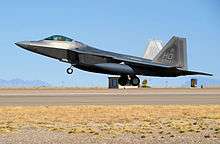
The inactivation of the 8th, however, was brief as it was re-activated on 25 Sept 2009, and equipped with the F-22A Raptor.[5] The 8th, was the second of two F-22A squadrons to be activated at Holloman and joined the previously-equipped 7th Fighter Squadron at Holloman AFB. The squadron was equipped with 18 F-22s, the last aircraft being received in 2010.[5]
Since its re-activation, the 8th Fighter Squadron deployed frequently to overseas locations in support of United States objectives.[5] However, after less than two years of operating F-22s, in 2010 it was announced that the squadron would stand down due to the Air Force’s Raptor fleet consolidation plan, which called for Holloman to give up its two squadrons of F-22s for two F-16 Fighting Falcon training squadrons. As a result, some of the 8th FS F-22s went temporarily to the 7th Fighter Squadron, while others were transferred to the 3d Wing at Joint Base Elmendorf-Richardson, Alaska; the 1st Fighter Wing at Joint Base Langley-Eustis, Virginia, and to the USAF Weapons School at Nellis AFB, Nevada.[8]
On 19 May 2011, the 8th Fighter squadron was inactivated.[9][10]
Lineage
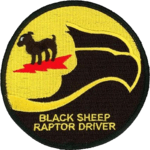




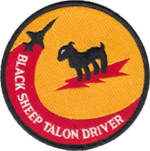
- Constituted as 8th Pursuit Squadron (Interceptor) on 20 Nov 1940
- Activated on 15 Jan 1941
- Re-designated: 8th Fighter Squadron on 15 May 1942
- Re-designated: 8th Fighter Squadron, Single Engine, on 20 Aug 1943
- Re-designated: 8th Fighter Squadron, Two Engine, on 6 Nov 1944
- Re-designated: 8th Fighter Squadron, Single Engine, on 8 Jan 1946
- Re-designated: 8th Fighter Squadron, Jet Propelled, on 1 May 1948
- Re-designated: 8th Fighter Squadron, Jet, on 10 Aug 1948
- Re-designated: 8th Fighter-Bomber Squadron on 1 Feb 1950
- Re-designated: 8th Tactical Fighter Squadron on 8 Jul 1958
- Re-designated: 8th Fighter Squadron on 1 Nov 1991
- Organized on 1 July 1993, absorbing assets of 416th Fighter Squadron (Inactivated)
- Deployed elements designated as 8th Expeditionary Fighter Squadron when assigned to an Air Expeditionary Unit
- Inactivated on: 16 May 2008
- Re-activated on: 25 Sept 2009
- Inactivated on: 19 May 2011[11]
Assignments
- Attached to: 49th Fighter-Bomber Wing, 15 Apr-15 Oct 1957
- 49th Fighter-Bomber (later, 49th Tactical Fighter; 49th Fighter) Wing, 10 Dec 1957
- Attached to: 26th Tactical Reconnaissance Wing, c. 15 Sep-8 Oct 1970 and 24 Aug-1 Oct 1971
- Attached to: 50th Tactical Fighter Wing, 8 Mar-2 Apr 1973 and 6 Sep-6 Oct 1975
- 49th Operations Group, 15 Nov 1991-16 May 2008; 25 Sept 2009-19 May 2011[11]
Stations
- Selfridge Field, Michigan, 15 Jan 1941
- Morrison Field, Florida, c. 23 May 1941-4 Jan 1942
- Essendon Airport, Melbourne, Australia, 2 Feb 1942
- RAAF Base Fairbairn, Canberra, Australia, 16 Feb 1942
- RAAF Base Darwin, Darwin, Australia, 17 Apr 1942
- Schwimmer Airfield (14 Mile Drome), Port Moresby, New Guinea, 25 Sep 1942
- Dobodura Airfield Complex, Dobodura, New Guinea, 15 Apr 1943
- Tsili Tsili Airfield, New Guinea, 30 Aug 1943
- Gusap Airfield, New Guinea, c. 29 Oct 1943
- Hollandia Airfield Complex, New Guinea, 3 May 1944
- Mokmer Airfield, Biak, Netherlands East Indies, 23 Jun 1944
- Tacloban Airfield, Leyte, Philippines, 25 Oct 1944
- McGuire Field, San Jose, Mindoro, Philippines, 2 Jan 1945
- Lingayen Airfield, Luzon, Philippines, 27 Feb 1945
- Okinawa, 17 Aug 1945
- Atsugi Airfield, Japan, 15 Sep 1945
- Chitose AB, Japan, c. 20 Feb 1946
- Misawa AB, Japan, 2 Apr 1948
- Ashiya AB, Japan, 30 Jun 1950
- Itazuke AB, Japan, 8 Jul 1950
- Taegu AB (K-2), South Korea, 29 Sep 1950
- Kunsan AB (K-8), South Korea, 1 Apr 1953
- Misawa AB, Japan, 4 Nov 1953-10 Dec 1957
- Étain-Rouvres AB, France, 10 Dec 1957
- Spangdahlem AB, West Germany, 25 Aug 1959-15 Jul 1968
- Holloman AFB, New Mexico, 15 Jul 1968–16 May 2008; 25 Sept 2009-19 May 2011
- Deployed to: Ramstein AB, West Germany, c. 12 Sep-c. 11 Oct 1970 and 10 Sep-6 Oct 1971
- Deployed to: Takhli RTAFB, Thailand, 12 May-4 Oct 1972
- Deployed to: Hahn AB, Germany, 3 Mar-5 Apr 1973 and 5 Sep-6 Oct 1975
- Deployed to: Ramstein AB, West Germany, 21 Sep-20 Oct 1976 and 22 Aug-22 Sep 1977[11]
Aircraft
- Seversky P-35, 1941
- P-40 Warhawk, 1942-1944
- P-47 Thunderbolt, 1943-1944
- P-38 Lightning, 1944-1946
- P-51 Mustang, 1946-1949, 1950
- F-80 Shooting Star, 1948-1951
- F-84 Thunderjet, 1951-1957
- F-100 Super Sabre, 1957-1962
- F-105 Thunderchief, 1962-1967
- F-4D Phantom II, 1967-1978
- F-15A/B Eagle, 1978-1992
- T-38 Talon, 1992-2008
- F-117A Nighthawk, 1992-2008
- F-22A Raptor, 2009-2011[11]
References
![]() This article incorporates public domain material from the Air Force Historical Research Agency website http://www.afhra.af.mil/.
This article incorporates public domain material from the Air Force Historical Research Agency website http://www.afhra.af.mil/.
- ↑ Pascalis and Ferguson (1996), Protect & Avenge: The 49th Fighter Group in World War II (Schiffer Military/Aviation History), Schiffer Publishing, Ltd. ISBN 0887407501
- 1 2 3 4 5 6 49th Fighter Wing History
- ↑ 202 Protect & Avenge S. W. Ferguson and William K. Pascalis
- ↑ Protect & Avenge S. W. Ferguson and William K. Pascalis
- 1 2 3 4 5 6 7 8 9 10 11 12 13 14 15 16 17 18 19 20 21 22 23 24 25 26 49th Wing History factsheet
- ↑ Martin, Patrick. Tail Code: The Complete History of USAF Tactical Aircraft Tail Code Markings. Schiffer Military Aviation History, 1994. ISBN 0-88740-513-4.
- 1 2 3 The Baghdad Strikes, Air Force Magazine, July 2003
- ↑ Bye-Bye, Black Sheep, Air Force Magazine, July 2011
- ↑ 8th FS ‘Black Sheep’ inactivated
- ↑ Laws, Joe. "8 FS inactivates." Alamogordo Daily News, 19 May 2011.
- 1 2 3 4 AFHRA 8th Fighter Squadron Lineage and History
